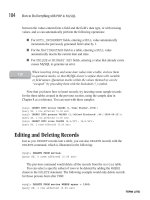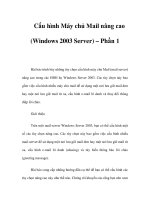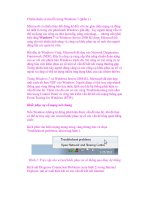Life with qmail phần 1 pps
Bạn đang xem bản rút gọn của tài liệu. Xem và tải ngay bản đầy đủ của tài liệu tại đây (807.31 KB, 10 trang )
Life with qmail
Table of Contents
1. Introduction 1
1.1. Audience 1
1.2. What is qmail? 1
1.3. Why use qmail? 1
1.4. History 2
1.5. Features 2
1.6. Related packages 4
1.7. Architecture 5
1.8. License 5
1.9. Comparison with other MTA's 5
1.10. Documentation 5
1.11. Support 7
2. Installation 11
2.1. Installation Issues 11
2.2. Preparation 12
2.3. System requirements 12
2.4. Download the source 13
2.5. Build the source 13
2.6. Install ucspi-tcp 17
2.7. Install daemontools 17
2.8. Start qmail 18
2.9. Test the Installation 26
3. Configuration 29
3.1. Configuration Files 29
3.2. Relaying 30
3.3. Multiple host names 31
3.4. Virtual domains 32
3.5. Aliases 32
3.6. qmail-users 33
3.7. Spam Control 34
3.8. Virus Scanning 34
4. Usage 35
4.1. .qmail files 35
4.2. Sending messages 37
4.3. Environment Variables 38
5. Advanced Topics 41
5.1. procmail 41
5.2. POP and IMAP servers 41
5.3. POP and IMAP clients 44
5.4. Multi-RCPT vs. Single RCPT delivery 45
5.5. VERP 46
5.6. Troubleshooting 46
5.7. Big Servers 49
5.8. Migrating from Sendmail to qmail 49
5.9. Mailing List Managers 49
5.10. Patches 50
Life with qmail
i
Table of Contents
5. Advanced Topics
5.11. QMTP 52
5.12. Rejecting Invalid Recipients During SMTP Dialogue 52
5.13. TLS and STARTTLS 52
A. Acknowledgments 53
B. Related Packages 55
B.1. dot-forward 55
B.2. fastforward 55
B.3. ucspi-tcp 55
B.4. daemontools 56
B.5. qmailanalog 56
B.6. rblsmtpd 56
B.7. serialmail 57
B.8. mess822 58
B.9. ezmlm 58
B.10. safecat 58
B.11. djbdns 58
B.12. maildrop 59
B.13. syncdir 59
C. How Internet Mail Works 61
C.1. How a message gets from point A to point B 61
C.2. More information 62
D. Architecture 65
D.1. Modular system architecture 65
D.2. File structure 65
D.3. Queue structure 66
D.4. Pictures 66
E. Infrequently Asked Questions 69
E.1. How frequently does qmail try to send deferred messages? 69
E.2. Why can't I send mail to a large site with lots of MX's? 70
E.3. What is QUEUE_EXTRA? 70
F. Error Messages 73
G. Gotchas 75
G.1. qmail doesn't deliver mail to superusers 75
G.2. qmail doesn't deliver mail to users who don't own their home directory 75
G.3. qmail doesn't deliver mail to users whose usernames contain uppercase letters 75
G.4. qmail replaces dots (.) in extension addresses with colons (:) 75
G.5. qmail converts uppercase characters in extension addresses to lowercase 75
G.6. qmail doesn't use /etc/hosts 75
G.7. qmail doesn't log SMTP activity 76
G.8. qmail doesn't generate deferral notices 76
G.9. qmail is slow if /var/qmail/queue/lock/trigger is gone/has the wrong permissions/is a
regular file 76
Life with qmail
ii
Table of Contents
G. Gotchas
G.10. DNS or IDENT lookups can make SMTP slow 76
G.11. Carriage Return/Linefeed (CRLF) line breaks don't work 76
G.12. qmail-send or tcpserver stop working if logs back up 77
G.13. qmail-smtpd doesn't validate the local part of an address 77
G.14. Firewalls can block remote access to your SMTP/POP3/IMAP server 77
G.15. qmail-inject sets From field to anonymous if USER and LOGNAME aren't set 77
G.16. qmail-send doesn't always exit immediately when killed 78
G.17. Delivering to /dev/null doesn't throw messages away 78
G.18. Modifying the queue while qmail-send is running is dangerous 78
H. Frequently Asked Questions about Life with qmail 79
H.1. What version is Life with qmail? 79
H.2. Who owns Life with qmail? 79
H.3. How is Life with qmail licensed? 79
H.4. How can I be notified when new releases of LWQ are made available? 79
H.5. Where can LWQ contributors and fans talk about it? 79
H.6. Has Life with qmail been translated to language? 79
H.7. Is Life with qmail available in PostScript, PDF, plain text, or any other format
beside HTML? 79
H.8. I used Life with qmail and it crashed my system/erased my hard disk/ruined my love
life/killed my dog/etc 79
H.9. How can I contribute to LWQ? 80
H.10. What's changed in this version of LWQ? 80
Life with qmail
iii
Life with qmail
iv
1. Introduction
1.1. Audience
Life with qmail is aimed at everyone interested in running qmail, from the rank amateur (newbie) who
just installed Linux on a spare PC all the way up to the experienced system administrator or mail
administrator. If you find it lacking or unclear, please let me know. Send comments to
There's a wealth of information available on qmail from a variety of sources. Some is targeted to
newbies, some assumes that the reader is more experienced. Life with qmail is an attempt to "glue"
this information into a single source, filling in some of the cracks and assuming only that the reader
has basic skills such as:
Manipulating files/directories under UNIX•
Operating a web browser or FTP client•
Following directions•
1.2. What is qmail?
qmail is an Internet Mail Transfer Agent (MTA) for UNIX-like operating systems. It's a drop-in
replacement for the Sendmail system provided with UNIX operating systems. qmail uses the Simple
Mail Transfer Protocol (SMTP) to exchange messages with MTA's on other systems.
Note: The name is "qmail", not "Qmail".
1.3. Why use qmail?
Your operating system included an MTA, probably Postfix or Sendmail, so if you're reading this
document you're probably looking for something different. Some of the advantages of qmail over
vendor-provided MTA's include:
1.3.1. Security
qmail was designed for high security. Sendmail has a long history of serious security problems. When
Sendmail was written, the Net was a much friendlier place. Everyone knew everyone else, and there
was little need to design and code for high security. Today's Internet is a much more hostile
environment for network servers. Sendmail's author, Eric Allman, and the current maintainer, Claus
Assman, have done a good job of tightening up the program, but nothing short of a redesign can
achieve true security.
1.3.2. Performance
qmail parallelizes mail delivery, performing up to 20 deliveries simultaneously, by default.
1.3.3. Reliability
Once qmail accepts a message, it guarantees that it won't be lost. qmail also supports a new mailbox
format that works reliably even over NFS without locking.
1. Introduction 1
1.3.4. Simplicity
qmail is smaller than any other equivalently-featured MTA.
Note: The official qmail web page, covers the advantages of qmail more
extensively.
1.4. History
qmail was written by Dan Bernstein (DJB), a math
professor now at the University of Illinois in Chicago. Dr. Bernstein is also well known for his work
in the field of cryptography and for his lawsuit against the U.S. government regarding the publishing
of encryption source code. See or
for information regarding the lawsuit.
The first public release of qmail, beta version 0.70, occurred on January, 24, 1996. The first gamma
release, 0.90, was on August, 1, 1996.
Version 1.0, the first general release, was announced on February, 20, 1997. The current version,
1.03, was released on June, 15, 1998.
The next release is expected to be an evaluation version of 2.0. Some of things that might appear in
version 2 are covered at />1.5. Features
The qmail web page, has a comprehensive list of qmail's features. This
section is based heavily on that list.
1.5.1. Setup
Automatic adaptation to your UNIX variant no porting needed•
Automatic per-host configuration•
Quick installation no big list of decisions to make•
1.5.2. Security
Clear separation between addresses, files, and programs•
Minimization of setuid code•
Minimization of root code•
Five-way trust partitioning security in depth•
Optional logging of one-way message hashes, entire message contents, etc. (See What is
QUEUE_EXTRA? in Appendix E.)
•
1.5.3. Message construction
RFC 822 and RFC 1123 compliant•
Full support for address groups•
Automatic conversion of old-style address lists to RFC 822 format•
sendmail command for compatibility with current user agents•
Life with qmail
2 1.3. Why use qmail?
Header line length limited only by memory•
Host masquerading (See defaulthost)•
User masquerading (See MAILUSER and MAILHOST)•
Automatic Mail-Followup-To creation (See QMAILMFTFILE)•
1.5.4. SMTP service
RFC 821, RFC 1123, RFC 1651, RFC 1652, and RFC 1854 compliant•
8-bit clean•
RFC 931/1413/ident/TAP callback can help track spammers/forgers•
Relay control stops unauthorized relaying by outsiders•
No interference between relay control and aliases•
Automatic recognition of local IP addresses•
Per-buffer timeouts•
Hop counting•
Parallelism limit (via ucspi-tcp)•
Refusal of connections from known abusers (via ucspi-tcp)•
Relaying and message rewriting for authorized clients•
Optional RBL/ORBS support (via rblsmtpd)•
1.5.5. Queue management
Instant handling of messages added to queue•
Parallelism limits•
Split queue directory no slowdown when queue gets big•
Quadratic retry schedule old messages tried less often (see Appendix E)•
Independent message retry schedules•
Automatic safe queueing no loss of mail if system crashes•
Automatic per-recipient checkpointing•
Automatic queue cleanups•
Queue viewing (See qmail-qread)•
Detailed delivery statistics (via qmailanalog)•
1.5.6. Bounces
QSBMF bounce messages both machine-readable and human-readable•
HCMSSC support language-independent RFC 1893 error codes•
Double bounces sent to postmaster•
1.5.7. Routing by domain
Any number of names for local host (See locals)•
Any number of virtual domains (See virtualdomains)•
Domain wildcards (See virtualdomains)•
Configurable "percent hack" support (See percenthack)•
UUCP hook•
1.5.8. SMTP delivery
RFC 821, RFC 974, and RFC 1123 compliant•
8-bit clean•
Life with qmail
1.5. Features 3
Automatic downed host backoffs•
Artificial routing smarthost, localnet, mailertable (See smtproutes)•
per-buffer timeouts•
Passive SMTP queue perfect for SLIP/PPP (via serialmail)•
AutoTURN support (via serialmail)•
1.5.9. Forwarding and mailing lists
Sendmail .forward compatibility (via dot-forward)•
Hashed forwarding databases (via fastforward)•
Sendmail /etc/aliases compatibility (via fastforward)•
Address wildcards (See .qmail-default)•
Mailing list owners automatically divert bounces and vacation messages•
VERPs automatic recipient identification for mailing list bounces•
Delivered-To automatic loop prevention, even across hosts•
1.5.10. Local delivery
User-controlled address hierarchy fred controls fred-anything mbox delivery•
Reliable NFS delivery (See maildir)•
User-controlled program delivery: procmail etc. (See qmail-command)•
Optional new-mail notification (See qbiff)•
Optional NRUDT return receipts (See qreceipt)•
Conditional filtering (See condredirect and bouncesaying)•
1.5.11. POP3 service
RFC 1939 compliant•
UIDL support•
TOP support•
APOP hook•
modular password checking (via checkpassword)•
1.6. Related packages
qmail follows the classic UNIX philosophy that each tool should perform a single, well-defined
function, and complex functions should be built by connecting a series of simple tools into a
"pipeline". The alternative is to build more and more complex tools that re-invent much of the
functionality of the simpler tools.
It's not surprising, then, that qmail itself doesn't do everything everyone might want it to do. Here,
then, are some of the most popular add-ons written for qmail. Of course, many standard UNIX
utilities can also be plugged into qmail.
dot-forward a Sendmail .forward file compatibility add-on•
fastforward a Sendmail alias database compatibility add-on•
ucspi-tcp an inetd replacement•
daemontools a set of tools for managing daemons and their logs•
qmailanalog a set of qmail log file analysis tools•
serialmail tools for mailing over slow networks•
mess822 tools for parsing Internet mail messages•
Life with qmail
4 1.5. Features









